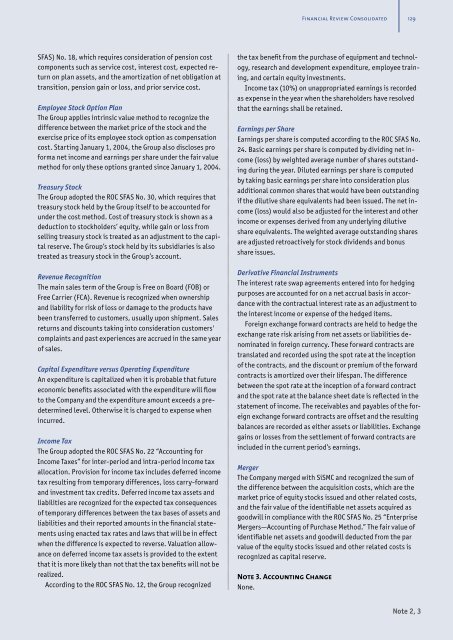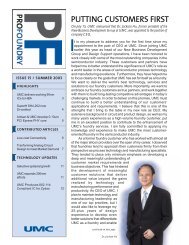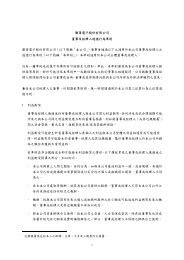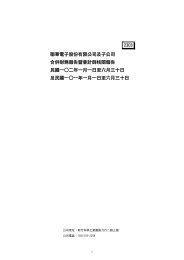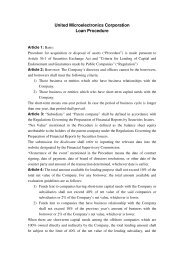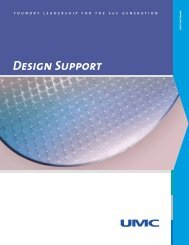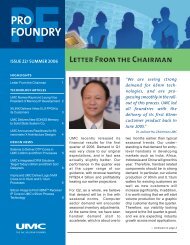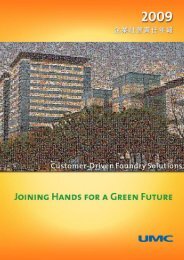Download Full Version - UMC
Download Full Version - UMC
Download Full Version - UMC
You also want an ePaper? Increase the reach of your titles
YUMPU automatically turns print PDFs into web optimized ePapers that Google loves.
Financial Review Consolidated<br />
129<br />
SFAS) No. 18, which requires consideration of pension cost<br />
components such as service cost, interest cost, expected return<br />
on plan assets, and the amortization of net obligation at<br />
transition, pension gain or loss, and prior service cost.<br />
Employee Stock Option Plan<br />
The Group applies intrinsic value method to recognize the<br />
difference between the market price of the stock and the<br />
exercise price of its employee stock option as compensation<br />
cost. Starting January 1, 2004, the Group also discloses pro<br />
forma net income and earnings per share under the fair value<br />
method for only these options granted since January 1, 2004.<br />
Treasury Stock<br />
The Group adopted the ROC SFAS No. 30, which requires that<br />
treasury stock held by the Group itself to be accounted for<br />
under the cost method. Cost of treasury stock is shown as a<br />
deduction to stockholders’ equity, while gain or loss from<br />
selling treasury stock is treated as an adjustment to the capital<br />
reserve. The Group’s stock held by its subsidiaries is also<br />
treated as treasury stock in the Group’s account.<br />
Revenue Recognition<br />
The main sales term of the Group is Free on Board (FOB) or<br />
Free Carrier (FCA). Revenue is recognized when ownership<br />
and liability for risk of loss or damage to the products have<br />
been transferred to customers, usually upon shipment. Sales<br />
returns and discounts taking into consideration customers'<br />
complaints and past experiences are accrued in the same year<br />
of sales.<br />
Capital Expenditure versus Operating Expenditure<br />
An expenditure is capitalized when it is probable that future<br />
economic benefits associated with the expenditure will flow<br />
to the Company and the expenditure amount exceeds a predetermined<br />
level. Otherwise it is charged to expense when<br />
incurred.<br />
Income Tax<br />
The Group adopted the ROC SFAS No. 22 “Accounting for<br />
Income Taxes” for inter-period and intra-period income tax<br />
allocation. Provision for income tax includes deferred income<br />
tax resulting from temporary differences, loss carry-forward<br />
and investment tax credits. Deferred income tax assets and<br />
liabilities are recognized for the expected tax consequences<br />
of temporary differences between the tax bases of assets and<br />
liabilities and their reported amounts in the financial statements<br />
using enacted tax rates and laws that will be in effect<br />
when the difference is expected to reverse. Valuation allowance<br />
on deferred income tax assets is provided to the extent<br />
that it is more likely than not that the tax benefits will not be<br />
realized.<br />
According to the ROC SFAS No. 12, the Group recognized<br />
the tax benefit from the purchase of equipment and technology,<br />
research and development expenditure, employee training,<br />
and certain equity investments.<br />
Income tax (10%) on unappropriated earnings is recorded<br />
as expense in the year when the shareholders have resolved<br />
that the earnings shall be retained.<br />
Earnings per Share<br />
Earnings per share is computed according to the ROC SFAS No.<br />
24. Basic earnings per share is computed by dividing net income<br />
(loss) by weighted average number of shares outstanding<br />
during the year. Diluted earnings per share is computed<br />
by taking basic earnings per share into consideration plus<br />
additional common shares that would have been outstanding<br />
if the dilutive share equivalents had been issued. The net income<br />
(loss) would also be adjusted for the interest and other<br />
income or expenses derived from any underlying dilutive<br />
share equivalents. The weighted average outstanding shares<br />
are adjusted retroactively for stock dividends and bonus<br />
share issues.<br />
Derivative Financial Instruments<br />
The interest rate swap agreements entered into for hedging<br />
purposes are accounted for on a net accrual basis in accordance<br />
with the contractual interest rate as an adjustment to<br />
the interest income or expense of the hedged items.<br />
Foreign exchange forward contracts are held to hedge the<br />
exchange rate risk arising from net assets or liabilities denominated<br />
in foreign currency. These forward contracts are<br />
translated and recorded using the spot rate at the inception<br />
of the contracts, and the discount or premium of the forward<br />
contracts is amortized over their lifespan. The difference<br />
between the spot rate at the inception of a forward contract<br />
and the spot rate at the balance sheet date is reflected in the<br />
statement of income. The receivables and payables of the foreign<br />
exchange forward contracts are offset and the resulting<br />
balances are recorded as either assets or liabilities. Exchange<br />
gains or losses from the settlement of forward contracts are<br />
included in the current period’s earnings.<br />
Merger<br />
The Company merged with SiSMC and recognized the sum of<br />
the difference between the acquisition costs, which are the<br />
market price of equity stocks issued and other related costs,<br />
and the fair value of the identifiable net assets acquired as<br />
goodwill in compliance with the ROC SFAS No. 25 “Enterprise<br />
Mergers—Accounting of Purchase Method.” The fair value of<br />
identifiable net assets and goodwill deducted from the par<br />
value of the equity stocks issued and other related costs is<br />
recognized as capital reserve.<br />
Note 3. Accounting Change<br />
None.<br />
Note 2, 3


